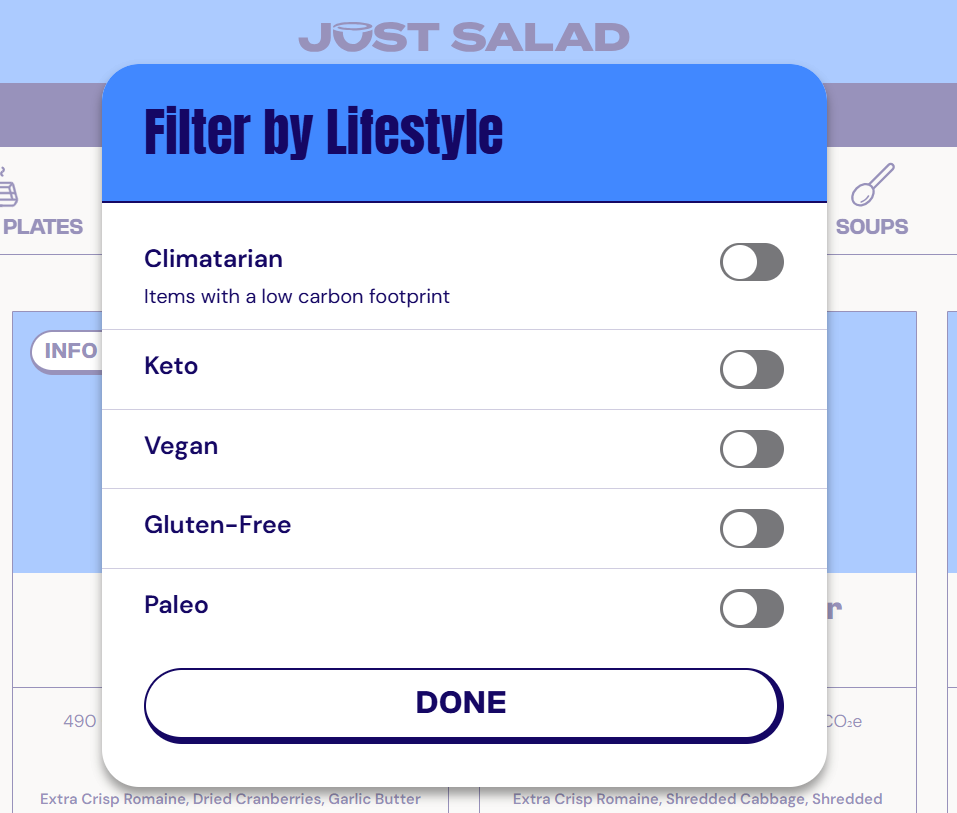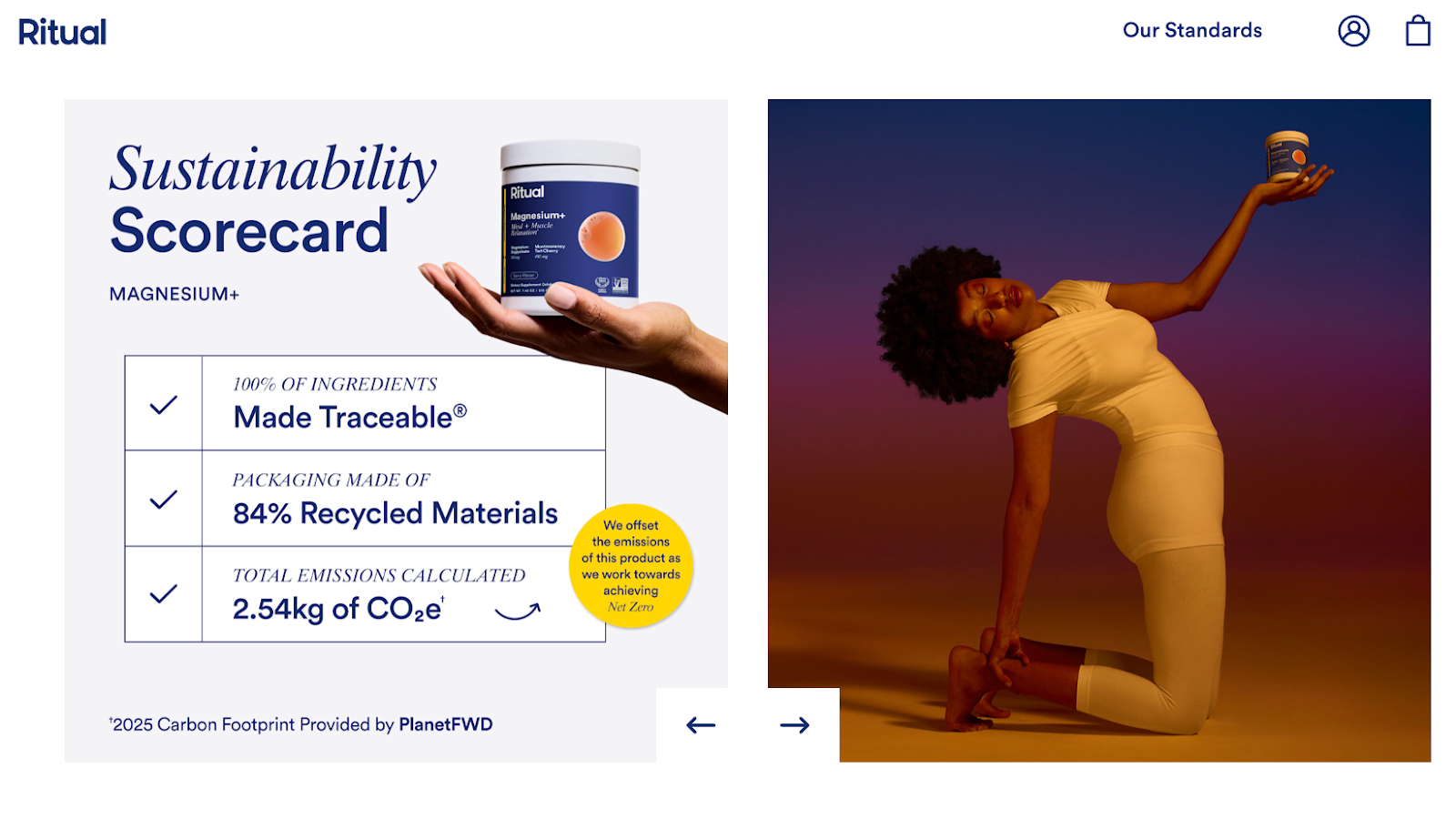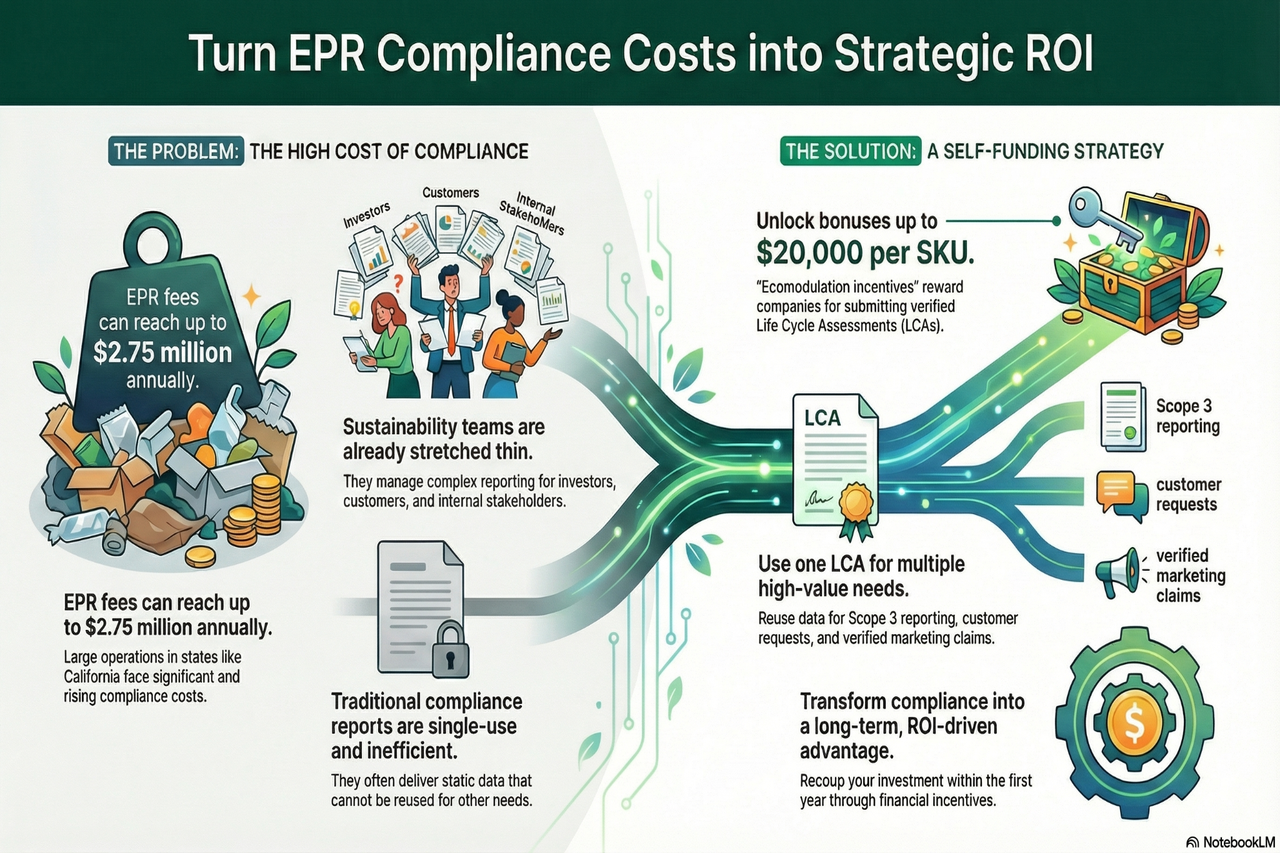The ROI of Product Sustainability
Learn how product sustainability can generate real ROI. This guide explains how consumer companies use LCAs, PCFs, and carbon labeling to increase sales, improve brand loyalty, and meet new regulations like EPR and California’s Climate Corporate Data Accountability Act. Backed by case studies and industry data.

Overview
This guide is for sustainability, ESG, and impact leaders at food, beauty, apparel, and packaging companies who need to prove that sustainability can deliver measurable business results. You’re balancing limited budgets with rising expectations — evolving regulations, customer data requests, and internal pressure to show return on investment.
Across the market, the evidence is clear: trusted, easy-to-understand sustainability action drives growth.
• Products with climate-friendly badges on Amazon saw a 13–14% sales lift within eight weeks
• Sustainability-marketed goods grew 5.6× faster than conventional products and drove over half of total CPG growth
• 80% of consumers are willing to pay roughly 10% more for sustainable products, even amid inflation
These results are consistent across industries and reinforce one key point — when product-level climate data becomes transparent, customers respond. Whether through carbon labels, online product pages, or menu icons, credible sustainability data builds trust and drives action.
We built this report to show that sustainability is not a cost center. Across categories, brands using Life Cycle Assessments (LCAs) and Product Carbon Footprints (PCFs) to communicate verified impact see faster growth, stronger loyalty, and measurable financial ROI.
Why Product Sustainability Matters Now
Environmental transparency has shifted from a nice-to-have to a business requirement. New state-level rules such as California’s Climate Corporate Data Accountability Act and EPR (Extended Producer Responsibility) demand product-level data, while retailers increasingly expect verified climate information from their suppliers.
At the same time, consumers are rewarding clarity and transparency. They still care significantly about price and performance, but they’re choosing brands that prove lower impact with facts, not just claims.
Brands closing that gap — linking their footprint data with packaging, design, and storytelling — can turn sustainability into an advantage rather than an obligation.
Examples across sectors:
• Matriark Foods and Bragg use LCAs to validate sourcing and strengthen retailer trust.
• Compass Group uses Planet FWD’s supplier engagement platform to scale primary data collection across thousands of vendors—enabling 11% average emissions reductions and creating a repeatable model for supplier-led improvement
• CookUnity uses LCAs to identify that 61% of its emissions came from inputs, not kitchens. These insights powered its Climate-Friendly Collection, helping chefs design lower-carbon recipes that resonate with conscious consumers
• Just Salad uses Planet FWD-verified carbon labels to help customers make informed menu choices. Its Climatarian Menu launch drove a 10% sales increase and doubled consumer engagement with lower-footprint items.

• Ritual integrates LCAs into its product portfolio to map emissions by ingredient and packaging type, informing procurement and innovation. Its use of regenerative pea protein—nine times less carbon intensive than whey—helped differentiate in a crowded supplement market.

• Seed embeds LCAs into its corporate inventory, using the data to target supplier renewable energy initiatives that outperformed initial transport-focused strategies—linking emissions reduction directly to business growth
• The Good Housekeeping Institute partnered with Planet FWD to launch its Green Seal program, bringing verified carbon data into mainstream consumer decision-making. By pairing 100 years of product-testing trust with transparent climate data, the program helps consumers buy confidently and gives participating brands credible proof of impact.
When strategy, verification, and circularity intersect, sustainability becomes repeatable and profitable.
What the Broader Evidence Shows
Market research is remarkably consistent: verified sustainability can drive measurable growth.
• Amazon Climate Pledge Friendly: Products earning the badge saw a 13–14% sales lift within eight weeks.
• Carbon-label pilots (Denmark / Australia): Low-footprint products gained ~4% in sales; high-footprint products declined ~6%.
• NYU Stern Sustainable Market Share Index: Sustainability-marketed goods grew 5.6× faster than conventional products and delivered 55% of total CPG growth.
• PwC 2024 Consumer Survey: 80% of shoppers are willing to pay a ~10% premium for sustainable products, even amid inflation.
The pattern is clear: sustainability visibility can help close the intention <> action gap.
Breaking Down the True ROI
Typical Costs
• LCAs / PCFs for key SKUs from PlanetFWD: $4K–$10K each
• Third party verification / certification through our partners: $8K–$20K
• Label design / communication: variable by channel
Refresh cadence: every 3–5 years or when materials change
Returns in Numbers

Beyond revenue, brands gain:
• Pricing flexibility (≈10% premium for verified products)*
• Retailer preference via Scope 3 transparency
• Operational savings from hotspot analysis
• Regulatory readiness ahead of disclosure mandates
For most brands, payback arrives within one planning cycle.
Roadmap for Action
Phase 1: Pilot and Learn (0–4 months)
• Select 2–3 high-volume SKUs and run LCAs
• Add simple, verified labeling
• Track sales and engagement vs. baseline
Phase 2: Scale and Optimize (4–12 months)
• Expand to more SKUs and suppliers.
• Introduce third-party validation where it drives access or trust
• Refine messaging with A/B testing and category benchmarks
Phase 3: Integrate and Lead (Year 2+)
• Embed LCAs in product development and supplier programs.
• Publish progress regularly.
• Use data for design, procurement, and marketing alignment.
Beyond the ROI Data: Why Qualitative Results Matter
Numbers prove short-term gain, but qualitative outcomes sustain momentum.
• Trust: Third-party validation eliminates greenwashing risk and strengthens brand reputation.
• Team alignment: Data clarity gives design, procurement, and marketing a shared language.
• Innovation: Hotspot visibility uncovers new materials, packaging formats, and partnerships.
• Culture: Transparency builds internal pride and consumer loyalty.
Why This Matters: Authentic storytelling builds brand loyalty and differentiates products in ways that pure metrics cannot. For example, Patagonia's billion-dollar business is fundamentally built on environmental narrative, not just product attributes.

Impact storytelling grounded in credible data deepens emotional connection—the type of equity that compounds long after the initial sales lift.
Other FAQs
How often should LCAs be updated?
Every 3–5 years or when materials, suppliers, or manufacturing methods change.
How does this support compliance?
Product LCAs feed directly into Scope 1–3 reporting and EPR submissions, reducing duplicate work.
How soon can ROI appear?
Brands typically see commercial signals within one quarter of launching transparent labeling or verified claims.
Closing
Sustainability has matured from an aspiration to a norm. But there’s a clear gap between companies that say they’re leading on sustainability and companies that can point to data, facts and action to prove that they are. The data shows that transparent, credible product sustainability drives growth and resilience.
You don’t capture ROI by just measuring once—you capture it by measuring precisely, making impact visible where decisions happen, and using those insights to improve continuously.
The brands doing this work today are proving the point: what gets measured and messaged gets chosen.
Citations
Amazon Climate Pledge Friendly Study | Harvard Business Review
NYU Stern Center for Sustainable Business | Sustainable Market Share Index
PwC (2024) Voice of the Consumer Survey - PwC's 2024 consumer survey found that consumers are willing to spend an average of 9.7% more on sustainably produced or sourced goods—even amid cost-of-living concerns and inflationary pressures.
Carbon Label Field Studies (Denmark / Australia)
McKinsey & NielsenIQ Sustainability Research
Carbon Trust Consumer Research (2020)
Planet FWD Customer Case Studies: Seed, Thrive Market, Everlane, Compass Group, Bragg, CookUnity, Ritual, Just Salad
Head of marketing
Lorem ipsum dolor sit amet, consectetur adipiscing elit. Consectetur, adipiscing elit, sed do eiusmod tempor incididunt ut lab. Lorem ipsum dolor sit amet, consectetur adipiscing elit. Lorem ipsum dolor sit amet, consectetur adipiscing elit.
This is an example blog post style
Lorem ipsum dolor sit amet, consectetur adipiscing elit, sed do eiusmod tempor incididunt ut labore et dolore magna aliqua. Sed vulputate odio ut enim. Volutpat sed cras ornare arcu dui. Lorem dolor sed viverra ipsum. Luctus accumsan tortor posuere ac ut consequat semper. Viverra justo nec ultrices dui sapien eget mi proin. Mollis nunc sed id semper risus in hendrerit gravida rutrum. Lacinia quis vel eros donec. Nisi vitae suscipit tellus mauris a diam. Ac orci phasellus egestas tellus rutrum tellus pellentesque eu tincidunt. Morbi quis commodo odio aenean sed adipiscing diam. Urna duis convallis convallis tellus id interdum. Tortor vitae purus faucibus ornare suspendisse sed. Vehicula ipsum a arcu cursus vitae congue. Enim sed faucibus turpis in. Orci eu lobortis elementum nibh tellus molestie nunc non blandit.
Nunc id cursus metus aliquam eleifend mi in. A erat nam at lectus urna duis convallis convallis. Tristique senectus et netus et malesuada fames ac. Id interdum velit laoreet id donec. Egestas dui id ornare arcu odio. Gravida rutrum quisque non tellus orci ac auctor. Malesuada fames ac turpis egestas maecenas pharetra convallis. Ut diam quam nulla porttitor. Eget nunc lobortis mattis aliquam faucibus purus. Aenean sed adipiscing diam donec adipiscing tristique risus nec. Nisi est sit amet facilisis magna etiam tempor orci eu. Tortor posuere ac ut consequat.
“Lorem ipsum dolor sit amet, consectetur adipiscing elit”
<span class="blockquote-wrap">
<strong>Naomi</strong>
Head of marketing
</span>

This is an example blog post style
Lorem ipsum dolor sit amet, consectetur adipiscing elit, sed do eiusmod tempor incididunt ut labore et dolore magna aliqua. Sed vulputate odio ut enim. Volutpat sed cras ornare arcu dui. Lorem dolor sed viverra ipsum. Luctus accumsan tortor posuere ac ut consequat semper. Viverra justo nec ultrices dui sapien eget mi proin. Mollis nunc sed id semper risus in hendrerit gravida rutrum. Lacinia quis vel eros donec. Nisi vitae suscipit tellus mauris a diam. Ac orci phasellus egestas tellus rutrum tellus pellentesque eu tincidunt. Morbi quis commodo odio aenean sed adipiscing diam. Urna duis convallis convallis tellus id interdum. Tortor vitae purus faucibus ornare suspendisse sed. Vehicula ipsum a arcu cursus vitae congue. Enim sed faucibus turpis in. Orci eu lobortis elementum nibh tellus molestie nunc non blandit.
<span class="rtb-protip">
<span class="rtb-protip-title"></span>
<span class="rtb-protip-body">Lorem ipsum dolor sit amet, consectetur adipiscing elit, sed do eiusmod tempor incididunt ut labore et dolore magna aliqua. Ut enim ad minim.</span></span>
How to customize formatting for each rich text
- Lorem ipsum dolor sit amet, consectetur adipiscing elit sed do eiusmod
- Lorem ipsum dolor sit amet, consectetur adipiscing elit sed do eiusmod
- Lorem ipsum dolor sit amet, consectetur adipiscing elit sed do eiusmod
- Lorem ipsum dolor sit amet, consectetur adipiscing elit sed do eiusmod
Headings, paragraphs, blockquotes, figures, images, and figure captions can all be styled after a class is added to the rich text element using the "When inside of" nested selector system.
Static and dynamic content editing
A rich text element can be used with static or dynamic content. For static content, just drop it into any page and begin editing. For dynamic content, add a rich text field to any collection and then connect a rich text element to that field in the settings panel. Voila!
- Lorem ipsum dolor sit amet, consectetur adipiscing elit sed do eiusmod
- For static content, just drop it into any page and begin editing. For static content, just drop it into any page and begin editing.
- Lorem ipsum dolor sit amet, consectetur adipiscing
How to customize formatting for each heading
Headings, paragraphs, blockquotes, figures, images, and figure captions can all be styled after a class is added to the rich text element using the "When inside of" nested selector system.

